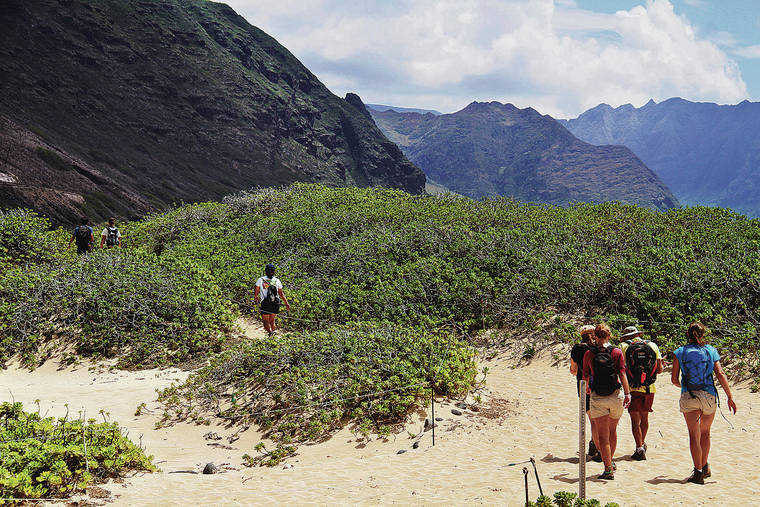Last year, after being inundated with visitors during 2019, Hawaii’s state parks experienced a nearly complete absence of tourists due to pandemic travel restrictions but were crowded with residents, many exploring parks for the first time for safe, free family activities and exercise, said Curt Cottrell, director of the Division of State Parks in the state Department of Land and Natural Resources.
Locals also were drawn by the absence of tourists: “When we reopened the Pali Lookout, I asked someone when was the last time he came up, and he said, ‘Ho, it’s been at least 30 years. I wanted to see the lookout without all the buses.”
Now, as tourism rebounds, parks division staff are seeing traffic increase, and while it’s too early to say whether local use will remain high, one thing is certain: No matter who recreational users are, their growing numbers and disrespect of park rules are overwhelming the parks’ fragile natural and cultural resources, creating friction with the islands’ host culture, whose traditional practices include fishing, gathering, camping, surfing and observing and nurturing nature.
This spring, for the first time, the division will focus on how to manage competing cultural and recreational interests as part of its regular, five-year reevaluation and updating of its Statewide Comprehensive Outdoor Recreation Plan, and is seeking public participation in meetings Wednesday and Saturday.
“We want to figure out ways to move the needle more in balance with cultural versus recreational use, to preserve the sanctity of these places,” Cottrell said.
Before their popularization on social media in 2015, the state park including Makua Beach, Keawaula (Yokohama Bay) and Kaena Point in Oahu’s Waianae district were relatively peaceful and pristine, said Micah Doane, whose family dates back to the late 1800s in Makua Valley.
“Now they’re swimming with dolphins, which stresses them and is not culturally appropriate and has really created tension with the leeward community, and the upper Makua cave hike,” said Doane, co-founder of Protectors of Paradise, a beach cleaning and restoration nonprofit that was appointed curator of Keawaula by the Board of Land and Natural Resources.
“There’s major damage: thousands of pounds of trash, human feces, people driving all over the beach and native plants,” he said, “with no law enforcement during nighttime hours and only one maintenance worker for that whole state park” due to budget constraints.
Meanwhile, the state has locked vehicle entry gates at Keawaula in an effort to prevent illegal camping and large group parties at Kaena Point.
“A lot of families are reporting they’re so sad to look at Makua and Keawaula as places being lost,” Doane added. “So many families don’t even want to go anymore because it’s just too stressful.”
Similar problems afflict state parks such as Kealakekua Bay on the Big Island, overwhelmed by dolphin swimmers, paddlers and snorkelers; Polihale on the west side of Kauai, where vehicles drive over sand dunes containing burials; and Little Beach at Makena, Maui, known on social media as a “naked beach,” Cottrell said.
Cottrell, Doane and community leaders in Waianae suggested better education to visitors through signs, websites and in-person engagement, and adding more reservation systems, such as has been successfully implemented at Haena State Park on Kauai.
“We malama (care for the environment) in our moku (district),” said Georgiana Navarro, vice president of the Makaha Hawaiian Civic Club, “and we can be letting other people know to be respectful, take care, wherever they go.”
“We really have a close-knit community, and everybody knows to pick up your opala and make sure no rough activity is going on,” said Rochelle Nohea Kawelo, president of Waianae Hawaiian Civic Club.
Traditional practices are sustainable, added Shirline Ho, president of Lualualei Hawaiian Civic Club.
“We fish here, we gather from the forests, but we do that according to the moon calendar” so as not to harm species’ reproductive cycles, Ho said, while Makahiki is a season to play games and celebrate the harvest, and such knowledge is key to understanding and perpetuating culture and place.
VIRTUAL PUBLIC MEETING
>> What: DLNR’s State Parks Division will hold virtual public information meetings on Hawaii’s Statewide Comprehensive Outdoor Recreation Plan, with opportunities for you to ask questions and share your thoughts; you can also take an outdoor recreation survey at dlnr.hawaii.gov/dsp/scorp Opens in a new tab through May 3.
>> When: 6-7:30 p.m. Wednesday and 9-10:30 a.m. Saturday
>> Where: For links to join the meetings, visit dlnr.hawaii.gov/dsp/scorp Opens in a new tab.

